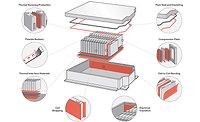Automakers are investing heavily in electric vehicle (EV) technology and are setting long-term goals for phasing out internal combustion engines. This strategic shift is driven by government policy, long-term competitiveness, and innovations in lithium-ion technology and production that have extended the EV driving range and reduced battery pack costs.
At the same time, more drivers are rethinking internal combustion engines in favor of electric motors powered by state-of-the-art battery packs. Lithium-ion batteries enabled the earliest EVs, and they remain the most common power supply for the latest models coming off of today’s assembly lines.
The EV space is an area that will provide tremendous opportunities for converters and others working with high-performance, pressure-sensitive adhesive (PSA) tapes. EV batteries provide a range of applications for converted, pressure-sensitive materials that enable those packs to be more efficient, safer, and easier to assemble.
Pressure-sensitive materials are suited for providing solutions for some of the most frustrating challenges that have faced OEMs and battery pack manufacturers as they have raced to improve their technologies. The major issues include reducing flammability, boosting dielectric strength, and protecting battery pack materials.
Acrylic- and silicone-based adhesives with flame-retardant* properties allow composites and other materials to meet UL® 94 V-0 and additional flame requirements. To address dielectric strength, single- and double-coated tapes incorporate dielectric films. OEMs and pack manufacturers should seek out materials and adhesives that are tested for breakdown voltage and dielectric strength requirements using GB/T 1408.1-2016 and ASTM D3755 test methods. To help protect pack materials, single- and double-coated tapes provide dimensional stability. In addition, easy-release liners can help protect delicate materials during assembly.

Figure 1. EV batteries provide a range of applications for converted, pressure-sensitive materials.
(Image courtesy of Avery Dennison.)
The converting and tape industry is poised to expand with continued EV growth. Various pressure-sensitive tape technologies can help solve the industry’s challenges with specific EV battery applications that converters can employ.
Cell-to-Cell Bonding
PSAs offer a quick and strong way to provide structural integrity in an EV battery pack. The use of pressure-sensitive tapes to bond pouch and/or prismatic cells together in EV battery pack assemblies offers key benefits:
- PSAs require no cure time, with immediate strength; they can act as an assembly aid and bonding solution, unlike liquid-applied products
- There is no need for mixing nozzles or pot life concerns, as PSAs feature single-component functionality
- Flame-retardant and dielectric tapes are available when there are flame or electrical requirements
Thermal Runaway Protection
Various materials are dedicated to preventing thermal runaway events, in which a domino effect of fire spreads from cell to cell in the battery pack. EV and battery manufacturers have strict requirements to protect against thermal runaway events and rely on mica, ceramic fibers, and other materials for protecting cells and passengers. Many solutions are available for bonding these materials to cells, modules, and pack structures:
- Flame-retardant adhesives that enable composites and materials to meet UL® 94 V-0 and other flame requirements
- Single- and double-coated film tapes for fiber encapsulation and dielectric strength
- Easy-release liners for preventing the cohesive failure of delicate, fibrous-based materials
Flexible Busbars
Flexible, printed circuits require electrical insulation and flame resistance. Busbars offer flexibility, safety, and cost effectiveness in EV battery applications. Adhesives are used to protect these flexible, printed circuits, and the bonds provide electrical insulation and flame retardancy.
Thermal Interface Materials
Thermal interface materials (TIMs) facilitate the transfer of heat between components in EV battery assemblies. Multiple adhesive solutions for TIMs bonded to either heat sinks or chiller plate materials assist with battery cell and battery module cooling. These include:
- High wet-out adhesives to lower thermal impedance between TIMs and the heat source
- Silicone-based PSAs offer excellent adhesion to silicone TIMs
- Acrylic-based PSAs offer first-rate adhesion to non-silicone-based TIMs
- Flame-retardant adhesives, tested in accordance with UL® 94 V-0, are also available
Electrical Insulation
Electrical insulation and cell wrapping are critical for protecting specific sensitive components in EV batteries. The best solution involves single- and double-coated tapes incorporating dielectric films for electrical insulation in EV batteries.
Double-coated tapes can be combined with other materials, such as compression pads, to achieve electrical insulation. Single-coated tapes can be applied to rigid materials like aluminum chill plates and other metal structures.
Compression Padding
Compression padding materials protect individual cells from damage caused by impact, movement, or swelling. Pressure-sensitive tapes are used to bond compression pad foam that protects EV battery cells.
Individual prismatic and pouch cells in EV battery packs need protection from impact and movement. Pouch cells can also swell during charging and discharging. To help prevent damage, EV battery manufacturers place foams backed with pressure-sensitive tape between each cell. The use of pressure-sensitive tapes for cell cushioning offers some key benefits:
- Requires no cure time and provides immediate strength; can act as an assembly aid and bonding solution, unlike liquid-applied products
- Full coverage adhesion between the metalized polyester pouch cell and cushion foam
- Flame-retardant and dielectric tapes are available when there are flame or electrical requirements
Pack Seal and Gasketing
Creating a tight seal for components is critical in the construction of EV battery assemblies. Heat-activated acrylic foam tapes help maintain a watertight seal between the casing and rubber gaskets. Acrylic foam tapes offer the following features:
- High durability and strength for demanding environments, shock absorption, and dynamic resistance
- Acrylic foam core enables gap filling between rigid components
- A continuous bondline helps seal out unwanted intrusion and reduces the need for fasteners
Collaborative Effort
Pressure-sensitive tapes are easy for converters, OEMs, and pack manufacturers to apply/assemble, and they provide a slim profile and a continuous bond across a large surface area. They are also generally lighter than mechanical fastening systems, which is a critical property as the automotive industry looks for ways to reduce battery pack and overall vehicle weight.
As electric vehicles and EV batteries continue to evolve, unknown needs and trials will develop. OEMs, tier suppliers, and converters will need to work together closely to understand the engineering challenges and design requirements to develop effective and reliable solutions.
For more information, visit https://tapes.averydennison.com/evbattery.
*Avery Dennison’s Flame Tough™



